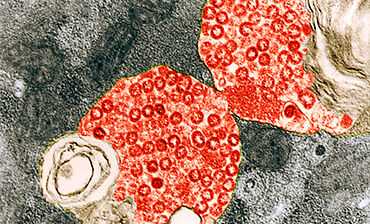Severe acute respiratory syndrome (SARS)

SARS is a severe respiratory disease caused by a coronavirus (SARS-CoV-1). It was initially an animal virus that crossed over to infect humans. The first human cases appeared in China in November 2002, but the syndrome was recognized three months later. The virus generally spread from person to person through respiratory droplets (coughs and sneezes). The last SARS case in humans was detected in 2004.
Symptoms appear after 3 to 10 days and include:
- fever
- general malaise
- diarrhoea
It can lead to pneumonia, which can be fatal in around 10% of cases (this rate is higher in the over 60s).
The source of SARS-CoV-1 is not completely known but it is believed that the virus jumped from an animal reservoir to humans. Bats are considered to be the natural reservoir of the virus, but some animals like civets and ferrets in southern China have been found to carry the virus. During the outbreak in Hong Kong, even domestic cats were infected. Recent experiments show that bats, ferrets, and domestic cats can efficiently transmit the virus, suggesting a wide range of animal species may act as sources of infection.




